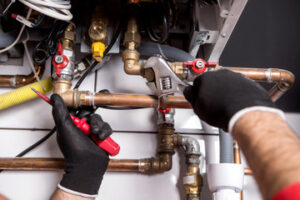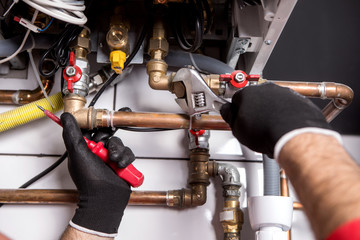Residential plumbing refers to any plumbing tasks performed in a person’s home. This can include the drains, toilets, and water lines. It can also refer to the piping that runs through people’s homes and apartment buildings.
 Determining smaller leaks and running toilets is easier in a residence since homeowners use their home plumbing regularly and will notice small issues that could lead to costly dripping and wasted water.
Determining smaller leaks and running toilets is easier in a residence since homeowners use their home plumbing regularly and will notice small issues that could lead to costly dripping and wasted water.
A clogged drain is one of every homeowner’s worst nightmares. These plumbing mishaps can lead to sewage backup, wastewater flooding, and even dangerous bacteria that pose health risks. While clogs are common, there are steps you can take to prevent them from happening in the first place.
Over time, hair, soap scum, and other debris can stick to the inside of your pipes. Once this material becomes too thick, it will start to block the flow of water. This is one of the most common causes of clogged drains and can be prevented by regularly cleaning your pipes.
Fatty substances like grease and fat can also build up in your pipes. These materials are particularly difficult to break down, and they will often solidify over time. If these substances are washed down your kitchen sink, they can cause a clog that may be difficult to clear.
Other causes of clogged drains include clothing, plastic bags, and other debris that finds its way into your pipes. These items will usually be pushed through your pipes by gravity, and they can cause significant damage or complete blockages if not cleaned quickly enough.
Another big contributor to clogged drains is tree roots. If a root gets stuck in a sewer line, it will gradually push its way through any cracks or stress lines until it reaches the drain opening. It’s important to have your sewer lines regularly inspected by a professional to ensure there are no underlying problems that could lead to a clog.
It’s also a good idea to keep an eye out for any unusual smells or signs of a foul odor. If you notice that the drain in your basement or upstairs bathroom is smelling especially bad, it’s likely due to a clog in your main sewer line. This is because sewage will back up into these drains when it can’t go anywhere else, and it will typically enter your home through its lowest point. This is often the bathtub or shower drain in a downstairs bathroom. If you notice this problem, it’s important to call a plumber immediately.
If you find puddles of water around your home without any obvious source, this may be a sign of a leaky water line. Water lines are responsible for bringing fresh water into your home, so any leaks can lead to serious problems if not addressed quickly.
Another common sign of a leaky water line is a sudden increase in your monthly water bill. If the increase is accompanied by other warning signs, such as a musty smell in a specific area or a change in your water flow, it’s time to call a plumbing professional.
The best way to determine the location of a leaky water line is by checking the soil in the area. The water supply pipe typically runs under the ground, so you will need to check both inside and outside your home for any damp areas. You can also check the water meter box, as leaks can sometimes travel back to this location.
Leaking pipes can cause a variety of problems, including mold and mildew growth, damage to your foundation, and increased water bills. A leaky water line can also cause your home’s structure to shift and create cracks, especially if the pipe is made of clay or concrete.
Once you have found the location of your leak, it’s important to turn off your home’s water supply. The water shut-off valve can usually be found in an easy-to-find location, such as the basement or crawl space. It is usually a knob or lever-type valve and can be turned counterclockwise to cut off the water supply.
It’s a good idea to drain all your faucets and toilets before shutting off the water. This will help to remove any water pressure that is left in your house and can make the job much easier.
Once the water is turned off, you can start to look for a repair professional. Some leaks can be repaired with a simple fix, such as tightening a joint or adjusting the water pressure. However, larger leaks will require the removal and replacement of a damaged section of pipe.
A clogged sewer line can cause problems throughout your home. If you notice sewage backing up into drains or toilets, contact a professional plumbing service right away. A plumber can inspect your entire system and determine the source of the problem, such as tree roots or an underlying broken pipe. Frequent sewage backups are a sign that the sewer line needs repair or replacement.
Foul odors around your property are another symptom of a failing sewer line. These odors come from bacteria, fecal matter and other waste that are leaching into the soil. These odors can be particularly noticeable in basements and utility rooms. A leak in the sewage line can also lead to mold growth and other structural damage within your home.
Another problem with a damaged sewer line is that it can cause the ground underneath your home to sink. This can cause a number of issues, including foundation cracks and even collapsed basement walls. In addition, a leaking sewer line can lead to a wet and soggy lawn. This can create a breeding ground for mosquitoes, as well as provide a home for rodents.
Damage to your sewer line can be caused by a number of factors, such as wear and tear, erosion, ground shifting, tree roots, and age. In general, older pipes made from outdated materials like Orangeburg and cast iron are more prone to break down and fail over time. These pipes can also be damaged by large amounts of rainwater that overflow the sewage system, leading to backups and other issues.
If your sewer line is prone to breaks and fractures, you may need to invest in a full replacement. Plumbers can install a new line using an open cut or trench method. This method allows them to minimize the amount of damage to your yard and landscaping. Typically, the plumber will need to dig a small trench in order to access the affected pipe section. However, if the break is more serious, they may need to dig a larger hole and replace the entire line.
In the case of residential plumbing, hydrostatic pressure tests are used to determine if drain line leaks are present. They are also conducted to determine if the drain line system is sound, which helps the plumber locate and fix problems. This type of test is also required to be completed prior to installing certain big home appliances such as water heaters.
The process is fairly simple. Your plumber will ensure that the drain lines are not currently in use (as in someone is not washing clothes or taking a shower or *anything* that would fill the pipe) and then they will pump water into the line through a hydrostatic pump to raise the PSI to a code specified amount. They will then monitor the pressure gauges to ensure that there is no drop and to detect if any water is escaping through a crack or a joint.
If no leaks are detected, the plumber will typically return the water pressure to normal and then inspect the plumbing lines by observing the solution of water and detergent poured onto suspected joints and connections. If the solution bubbles or foams it may indicate a leak. The plumbing technician will then check the pipes at a number of locations to locate and identify the source of the leak(s).
Testing a drain system with air is also an option, although the procedure is slightly different than for DWV systems. A test weenie is an inflatable device that has a pressure gauge attached to it, and they are available at any home improvement store. If you are using this method, your plumber will need to shut off the house water meter valve and the hot water heater shut-off valve before starting the test.
The plumber will place a test weenie in the lowest open drain at observation level, such as an exposed toilet drain or a stand up shower stall drain. They will then inflate the weenie until it is full and block off the pipe with it. They will then observe the water level at observation level for 15 – 30 minutes. If the water level drops it indicates leaks in the drain line system. This is the most accurate way to test plumbing pipes for leaks without having to cut into them.
